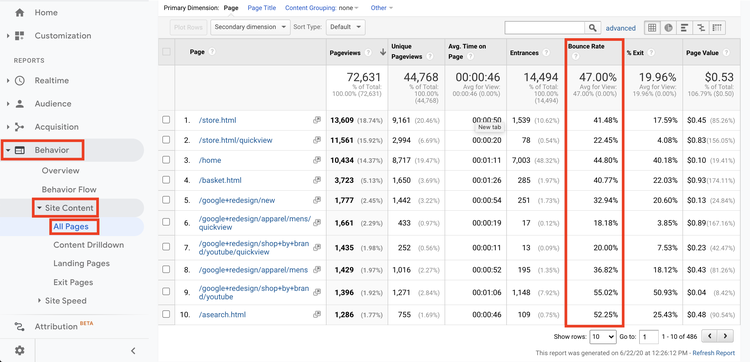Any SEO expert, web marketer, product manager, or business owner knows that nothing can be improved without measurement. And the fact that SEO is entirely based on graphs and figures is a good thing. But what measures work best for gauging SEO success? Let’s find out.
- Organic traffic
Organic traffic displays the number of users who arrived at a website as a result of searches made on search engines such as Google, Yahoo!, Bing, and others. This metric is probably one of the most important SEO metrics, as it indicates a website’s overall ability to attract visitors. In other words, the better a website is optimized for search engines, the higher the number of visitors from organic search results should be.
Organic traffic is excellent for tracking the number of visitors to specific websites or pages and learning more about users, like their location, the devices they use, and other usage patterns. On top of that, it assists in identifying sudden drops in traffic and finding the potential causes, such as a website technical problem, a recent Google update, or if a rival website started outranking yours.
Tip: If you want to increase traffic to your site, you need to promote it whenever you can. Think how many emails a day you send. How about all the company employees? That’s a decent amount! What if we told you you could promote your website in every email you send without being spammy? We talk about email signatures. The email signature is a block added at the bottom of an email and contains your contact details, photo, logo, CTAs, essential links, etc. See these email signature examples to get a better idea of email signature marketing. If you like them, we encourage you to create a signature for yourself and the entire team with the help of the email signature generator. It’s fast and easy.
How do you measure organic traffic?
You can use Google Analytics to get a closer look at your traffic and analyze it. Check out total visits, traffic sources (e.g., direct, referral, paid, social, and search), etc.
- Organic conversions
The percentage of visitors that find your website through a search engine and perform the necessary action, frequently by filling out a form to become a lead or customer, is known as your organic conversion rate. If this measure isn’t as high as you’d like it to be, you can raise it by looking at user feedback and analytics to improve your site’s ability to generate income (boost leads and sales).
How do you measure conversions?
Setting up custom goals in Google Analytics is one approach to keep track of your conversion rates. With one of their pre-configured templates, you can create goals. From there, you can enter visitor goals like reading an article, watching a video, signing up for emails, taking a course, and any other actions that cause a visitor to convert to a subscriber or buyer.
- Time on page
The amount of time spent on a web page is calculated as the amount of time between when a user first lands on the page and when they move on to the next one. When you click a link to go to the next page of a website, the time spent on the previous page is recorded. The Time On Page is zero if the user leaves the website without viewing any more pages.
The average amount of time that each website visitor spends on a given page is determined by the web analytics metric known as Average Time on Page. This metric measures the average amount of time users spend on non-exit pages rather than taking exit pages or bounces into account.
When used properly, this statistic can reveal if viewers find the content engaging. If the average Time On Page is low, this means the user may not like the content. However, it’s important to keep in mind that time spent on a page is tracked even when a tab is open in the background and the page is open.
How do you measure Time On Page?
Google Analytics allows you to monitor the typical length of time visitors spend on your website. See “Behavior > Overview” on the dashboard’s left side.
Then, by comparing it to your own usual reading time, you may determine whether the amount of time spent on a page was too low. But also bear in mind the purpose of the page. A 60-second page visit is ideal for a lead magnet with a high conversion rate, but not for lengthy content. It is acceptable to assume that your content satisfies user purpose if the average reading time of your visitors is similar to your average reading time.
- Bounce rate
The percentage of visitors to a website that only view one page before leaving is known as the bounce rate. The content strategy can be reviewed and updated to better fulfill SEO objectives by keeping an eye on the website’s bounce rates.
For complicated websites with a multi-step sales funnel, this figure is a crucial sign. It demonstrates how effectively consumers engage with pages and progress farther down the funnel.
A high bounce rate indicates that the page is uninteresting and doesn’t encourage visitors to stay on the website, which has a negative impact on conversion rates. The page meets visitors’ needs and aids in traffic conversion if the bounce rate stays low.
A high bounce rate does not necessarily signify problems, though, if you employ easy landing pages with a clear call to action or instructional pages that provide thorough information on a certain topic without requiring any further activities.
How do you measure bounce rate?
With the help of a traffic analytics tool (for example, Google Analytics), you can quickly determine the bounce rate for your domain by the device (mobile or desktop) and determine whether there has been any recent progress by looking at the last six, twelve, and all-time periods.
- Page speed
The Google algorithm directly considers page speed when determining rankings. This metric can indirectly affect rankings by growing the bounce rate and decreasing dwell time.
How do you measure page speed?
To determine whether your website is quick, run it using Google’s PageSpeed Insights tool. 100 is a quick score. It’s deemed good to receive a score of 90 or above but less than 100. If your score was between 50 and 90, it needs to be raised. A score of 50 or less is regarded as poor.
- Keyword rankings
The term “keyword rankings” describes a website’s organic placements in the search results for specific keywords. And it’s more advantageous for you to rank well for a keyword the more it relates to your product and business.
How do you measure keyword rankings?
Conducting a Google search is an easy way to monitor your ranking for keywords associated with your company or products. You can see in the results where your website stands. Given that more than 25% of users click on the first Google search result, the ultimate objective is to appear on the first page and as near the top of Google as feasible.
Final thoughts
Measuring your results is a crucial part of the SEO process. It’s how you determine whether your plan is effective, what sorts of outcomes you’re getting, and where you may make improvements in the future. If you haven’t already, you should start measuring SEO metrics like organic traffic, organic conversions, bounce rate, keyword ranks, and time on page. Fortunately, this is comparatively easy thanks to tools like Google Analytics. We also introduced to you a free tool that helps promote your website for free to increase traffic – email signatures. See how it all makes a difference to your business.











Add Comment